SEO Cost vs Revenue: What SaaS Companies Should Expect to Invest in 2025
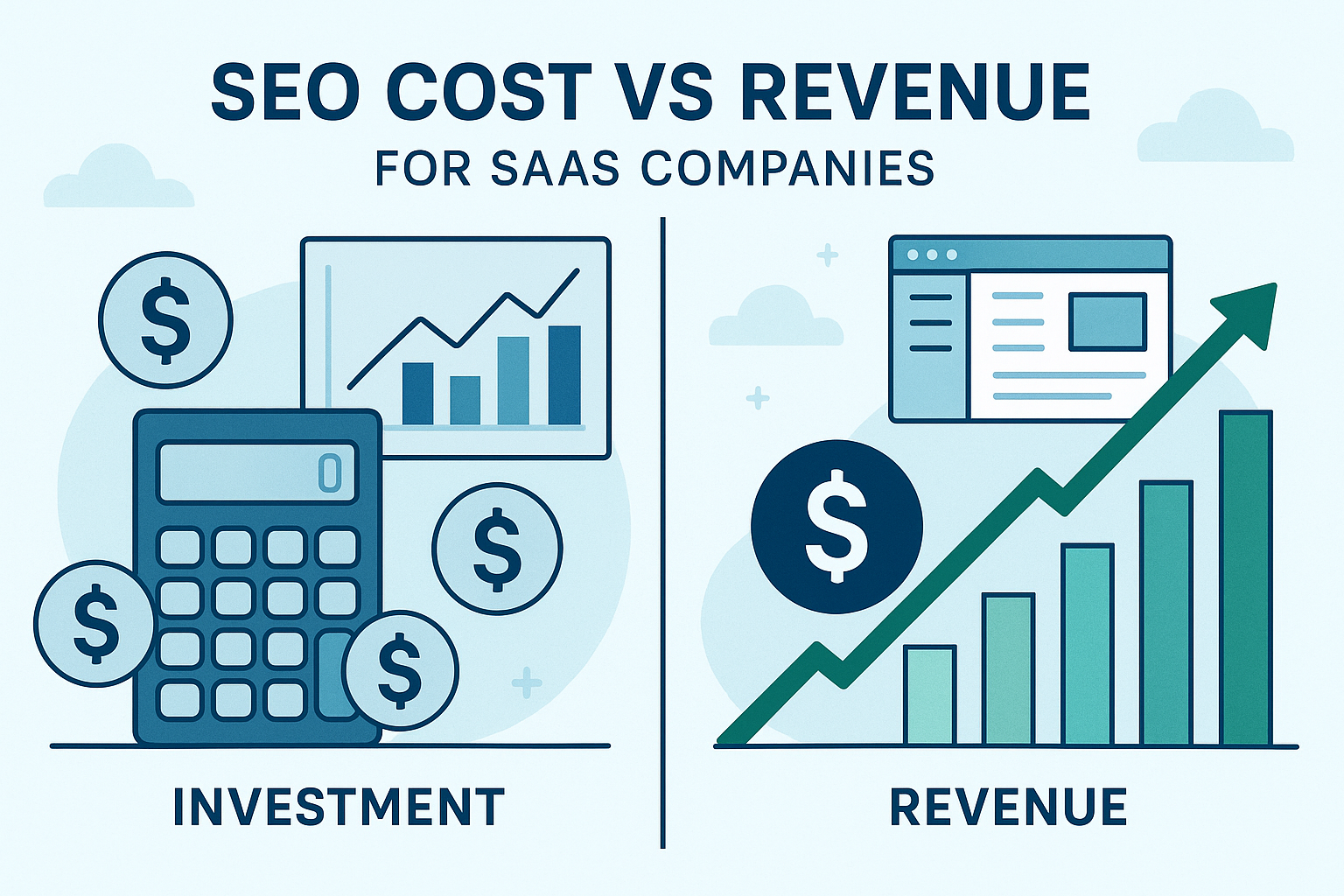
When SaaS executives ask "How much should we invest in SEO?" they're really asking "What return can we expect from our SEO investment?" The answer isn't just about SEO pricing—it's about understanding the relationship between SEO costs and revenue generation that can make or break your growth strategy.
In 2025, SaaS companies investing strategically in search engine optimization are seeing an average ROI of 702%, with some achieving breakeven in just 7 months. But here's the catch: the investment levels, timeline expectations, and revenue outcomes vary dramatically based on your approach.
This comprehensive guide breaks down exactly what SaaS companies should expect to invest in SEO, the revenue returns you can anticipate, and how to calculate whether your SEO investment makes financial sense for your business.
Table of Contents
1.The Real Cost of SEO for SaaS Companies in 2025
2.SEO Investment Tiers: Finding Your Sweet Spot
3.Revenue Expectations: What ROI Can You Realistically Achieve?
4.SEO vs Paid Advertising: The Long-Term Revenue Comparison
5.How to Calculate Your SEO Investment Breakdown
6.Timeline to Revenue: When SaaS Companies See Results
7.Measuring Success: Key Metrics That Drive Revenue
8.Working with SEO Specialists: Investment vs In-House
The Real Cost of SEO for SaaS Companies in 2025
The SEO landscape for SaaS companies has evolved significantly, with investment requirements becoming more sophisticated and results-driven. Unlike generic SEO pricing, SaaS SEO costs reflect the complexity of B2B sales cycles, technical product requirements, and the need for sustained organic growth.
Current Market Pricing for SaaS SEO
Based on comprehensive market analysis of 2025 pricing data, here's what SaaS companies are actually investing in search engine optimization:
Hourly SEO Consulting Rates:
•Entry-level SEO specialists: $75-$125/hour
•Experienced SaaS SEO consultants: $150-$200/hour
•Enterprise SEO strategists: $200-$300/hour
Monthly SEO Investment Ranges:
•SaaS startups (0-$1M ARR): $1,500-$4,500/month
•Growth-stage SaaS ($1M-$10M ARR): $4,500-$10,000/month
•Enterprise SaaS ($10M+ ARR): $10,000-$25,000/month
Project-Based SEO Services:
•SEO audit and strategy: $2,500-$7,500
•Technical SEO implementation: $5,000-$15,000
•Content strategy development: $3,000-$10,000
These figures represent a 15-20% increase from 2024, reflecting the growing complexity of search algorithms and the increased competition in SaaS markets.
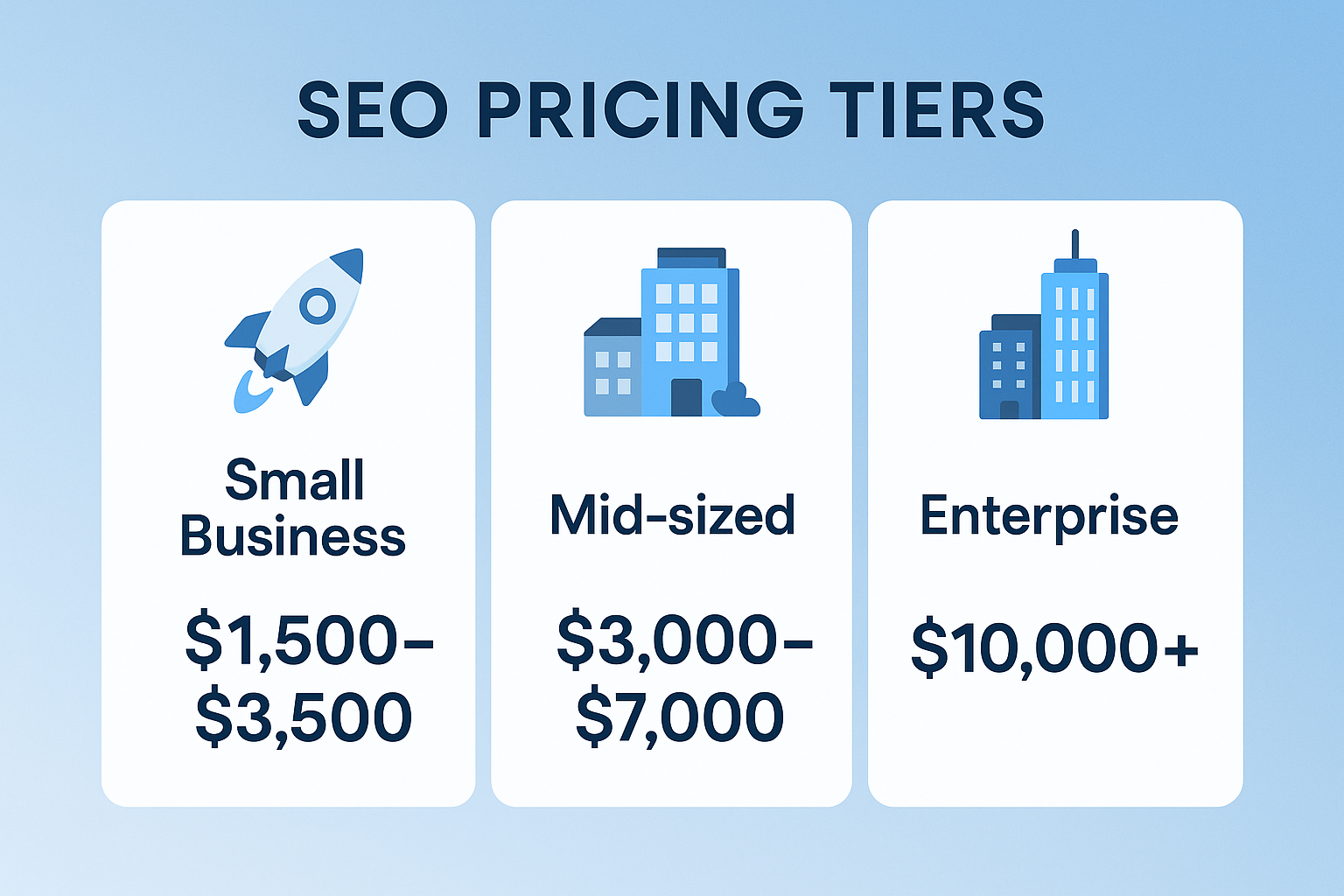
What Drives SaaS SEO Costs Higher?
Several factors make SaaS SEO more expensive than traditional local or e-commerce SEO:
Technical Complexity: SaaS websites often require sophisticated technical SEO implementations, including API documentation optimization, dynamic content management, and complex site architectures.
Content Depth Requirements: B2B SaaS buyers consume significantly more content before making purchasing decisions, requiring comprehensive content strategies that address multiple buyer personas and decision-making stages.
Competitive Landscape: Popular SaaS categories like CRM, project management, and marketing automation face intense competition for high-value keywords, driving up the investment needed for meaningful rankings.
Long Sales Cycles: SaaS companies need SEO strategies that nurture prospects through extended evaluation periods, requiring more sophisticated content funnels and conversion optimization.
Geographic Pricing Variations
SEO costs also vary significantly by geographic focus:
•US/Canada-focused campaigns: Premium pricing due to high competition and market value
•European markets: Moderate pricing with multilingual considerations
•MENA region: Competitive pricing with cultural and language localization needs
•Global campaigns: Highest investment due to multi-market complexity
As an SEO specialist with extensive experience in MENA, US, and Pakistani markets, I've seen how geographic targeting significantly impacts both investment requirements and revenue potential. The key is aligning your SEO investment with your highest-value markets while building a foundation for global expansion.
SEO Investment Tiers: Finding Your Sweet Spot
Understanding where your SaaS company fits in the SEO investment spectrum is crucial for setting realistic expectations and budgets. Each tier represents different capabilities, timelines, and revenue outcomes.
Tier 1: Startup SEO Foundation ($1,500-$4,500/month)
Ideal for: SaaS companies with less than $1M ARR, limited marketing budgets, or those just beginning their SEO journey.
What's Included:
•Basic keyword research and competitive analysis
•Technical SEO audit and essential fixes
•4-8 optimized blog posts per month
•On-page optimization for key product pages
•Local SEO setup (if applicable)
•Monthly performance reporting
Expected Outcomes:
•25-50% increase in organic traffic within 6 months
•Improved rankings for 10-20 target keywords
•Foundation for long-term SEO growth
•Basic conversion tracking implementation
Revenue Impact: Companies in this tier typically see their first organic conversions within 3-4 months, with meaningful revenue contribution starting around month 6-8.
Tier 2: Growth-Stage SEO Acceleration ($4,500-$10,000/month)
Ideal for: SaaS companies with $1M-$10M ARR looking to scale organic acquisition and reduce customer acquisition costs.
What's Included:
•Comprehensive keyword strategy across multiple buyer personas
•Advanced technical SEO and site architecture optimization
•12-20 high-quality content pieces per month
•Link building and digital PR campaigns
•Conversion rate optimization for organic traffic
•Advanced analytics and attribution modeling
•Competitor monitoring and strategy adaptation
Expected Outcomes:
•75-150% increase in organic traffic within 12 months
•Top 10 rankings for 50+ target keywords
•Significant reduction in customer acquisition cost
•Improved organic conversion rates
Revenue Impact: This tier typically generates 15-25% of total revenue from organic channels within 12-18 months.
Tier 3: Enterprise SEO Domination ($10,000-$25,000+/month)
Ideal for: Enterprise SaaS companies with $10M+ ARR seeking market leadership and maximum organic visibility.
What's Included:
•Multi-market, multi-language SEO strategies
•Enterprise-level technical SEO and site performance optimization
•25+ premium content pieces per month
•Aggressive link building and thought leadership campaigns
•Advanced conversion optimization and personalization
•Dedicated SEO team with specialized expertise
•Real-time monitoring and rapid response capabilities
•Integration with sales and marketing automation systems
Expected Outcomes:
•200-400% increase in organic traffic within 18 months
•Market-leading positions for high-value keywords
•Organic channel contributing 30-50% of total revenue
•Industry thought leadership establishment
Revenue Impact: Enterprise-tier SEO investments often become the primary revenue driver, with some companies achieving 40-60% of new customer acquisition through organic channels.
Revenue Expectations: What ROI Can You Realistically Achieve?
The most critical question for SaaS executives isn't "How much does SEO cost?" but "What revenue can we expect from our SEO investment?" The data from 2025 shows remarkable returns for companies that invest strategically.
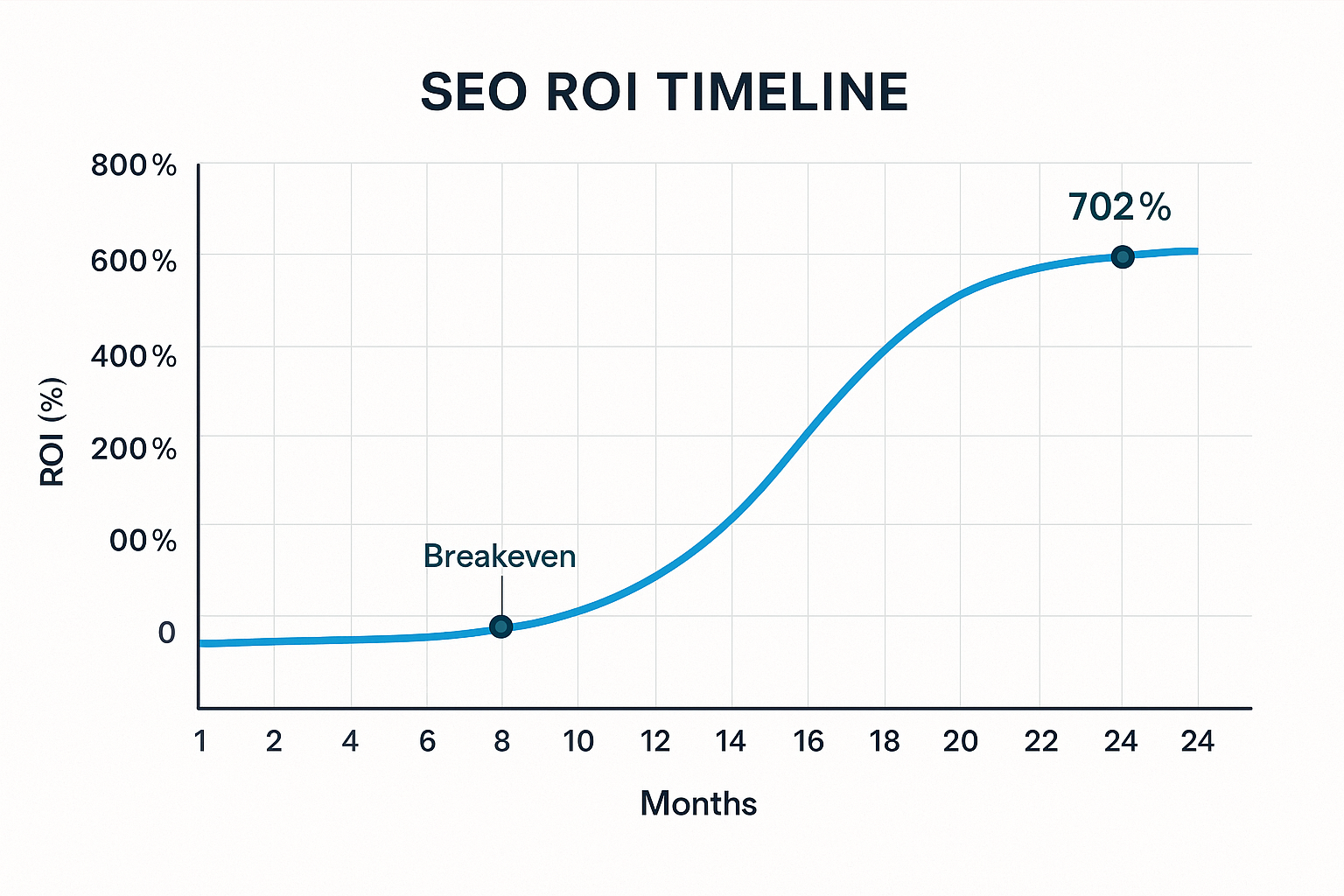
The 702% ROI Reality for SaaS Companies
Recent industry analysis reveals that B2B SaaS companies investing in comprehensive SEO strategies achieve an average ROI of 702% over 24 months. However, this figure requires context:
Breakeven Timeline: Most SaaS companies reach SEO breakeven between months 7-9, depending on their investment level and market competition.
Peak Performance: Maximum ROI typically occurs in months 18-24, when compound growth effects and domain authority improvements create exponential returns.
Sustained Growth: Unlike paid advertising, SEO ROI continues improving over time, with many companies seeing 800%+ returns in year three and beyond.
ROI by Investment Tier
Startup Tier ($1,500-$4,500/month):
•6-month ROI: 50-150%
•12-month ROI: 200-400%
•24-month ROI: 400-600%
Growth Tier ($4,500-$10,000/month):
•6-month ROI: 100-250%
•12-month ROI: 300-600%
•24-month ROI: 600-800%
Enterprise Tier ($10,000+/month):
•6-month ROI: 150-300%
•12-month ROI: 400-700%
•24-month ROI: 700-1000%+
Revenue Attribution Factors
Several factors influence your actual SEO ROI:
Customer Lifetime Value (CLV): SaaS companies with higher CLV see dramatically better SEO ROI because each organic conversion has greater long-term value.
Sales Cycle Length: Longer sales cycles may delay initial ROI but often result in higher-quality leads and better conversion rates.
Market Competition: Less competitive niches may achieve faster ROI, while highly competitive markets require longer investment periods but offer greater long-term returns.
Content Quality and Relevance: High-quality, buyer-focused content significantly improves both ranking speed and conversion rates.
Calculating Your Expected Revenue
To estimate your potential SEO revenue, use this framework:
1.Current organic traffic × Target growth percentage = Projected traffic
2.Projected traffic × Conversion rate = Expected leads
3.Expected leads × Close rate × Average deal size = Projected revenue
4.Projected revenue - SEO investment = Net ROI
Example: A SaaS company with 10,000 monthly organic visitors, 2% conversion rate, 15% close rate, and $5,000 average deal size could project:
•Current monthly revenue from organic: $1,500
•With 100% traffic growth: $3,000 monthly
•Annual organic revenue: $36,000
•ROI on $5,000/month SEO investment: 500%
SEO vs Paid Advertising: The Long-Term Revenue Comparison
One of the most important strategic decisions SaaS companies face is how to allocate marketing budget between SEO and paid advertising. The 2025 data reveals significant differences in long-term revenue generation.
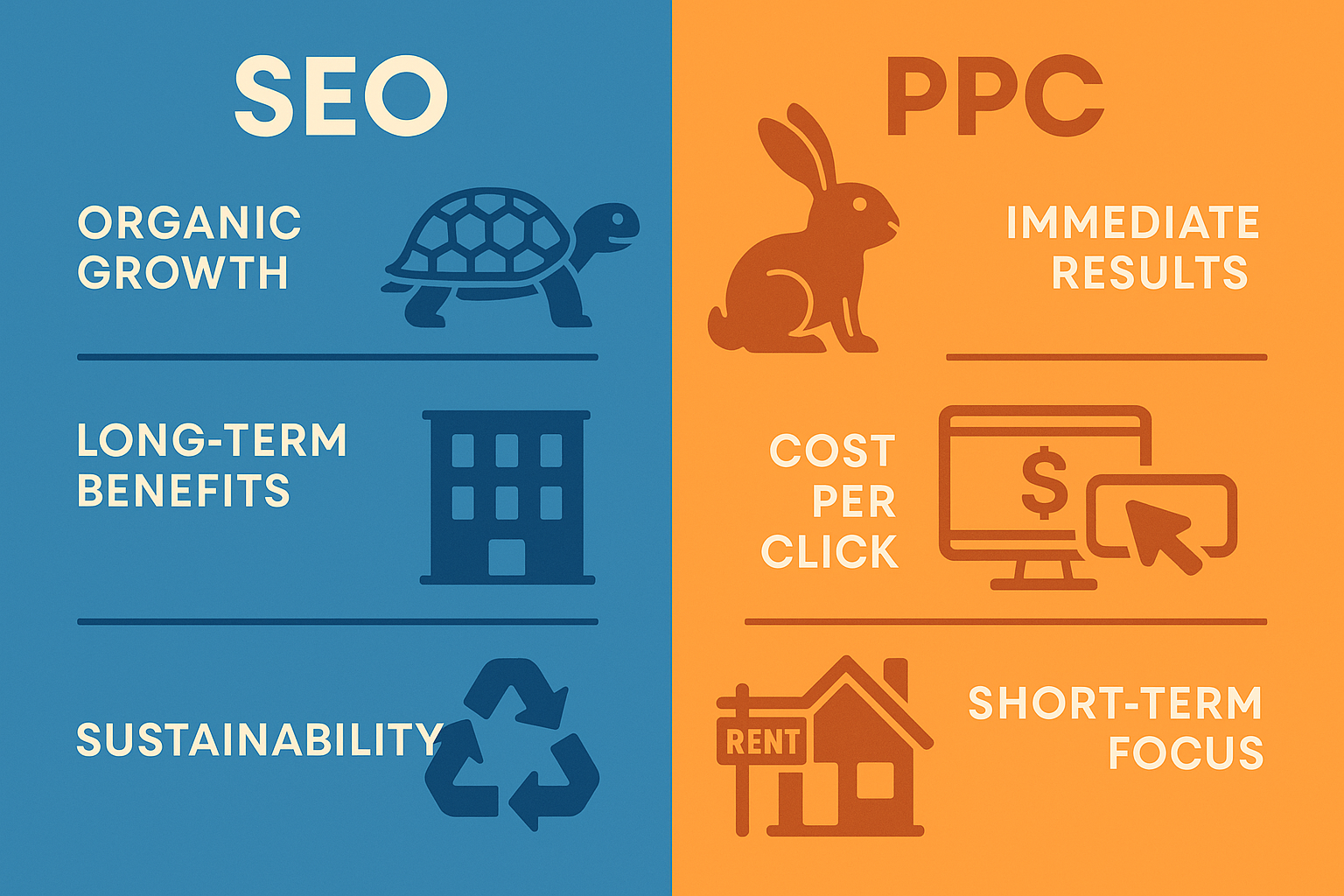
Immediate vs Sustainable Revenue
Paid Advertising Advantages:
•Immediate traffic and lead generation
•Precise targeting and budget control
•Quick testing and optimization cycles
•Predictable short-term ROI (average $2 for every $1 spent)
SEO Advantages:
•Compound growth effects over time
•Zero marginal cost for additional traffic
•Higher conversion rates (typically 2-3x higher than PPC)
•Sustainable competitive advantages
•Brand authority and trust building
The Crossover Point
Most SaaS companies experience a "crossover point" where SEO becomes more cost-effective than paid advertising:
•Month 1-6: PPC typically delivers better ROI
•Month 7-12: SEO and PPC ROI become comparable
•Month 13+: SEO significantly outperforms PPC in cost-effectiveness
Budget Allocation Strategy
Based on 2025 performance data, the optimal budget allocation for most SaaS companies is:
Year 1:
•60% paid advertising
•40% SEO investment
Year 2:
•40% paid advertising
•60% SEO investment
Year 3+:
•25% paid advertising
•75% SEO investment
This allocation allows companies to maintain immediate lead flow while building long-term organic assets.
Customer Quality Comparison
SEO consistently delivers higher-quality customers:
Average Customer Lifetime Value:
•SEO-acquired customers: 25-40% higher CLV
•Organic customers show 30% better retention rates
•Lower churn rates due to better product-market fit
Sales Cycle Efficiency:
•Organic leads typically have 20% shorter sales cycles
•Higher close rates due to better intent matching
•Reduced sales effort required per conversion
How to Calculate Your SEO Investment Breakdown
Understanding where your SEO budget goes is crucial for evaluating value and making informed investment decisions. Here's how successful SaaS companies allocate their SEO investments for maximum revenue impact.

The Optimal SEO Budget Allocation
Content Creation (30%):
•High-quality blog posts and guides
•Product-focused landing pages
•Case studies and success stories
•Technical documentation optimization
•Video and multimedia content
Technical SEO (25%):
•Site speed and performance optimization
•Mobile responsiveness improvements
•Schema markup implementation
•Site architecture and navigation
•Core Web Vitals optimization
Link Building (20%):
•Digital PR and outreach campaigns
•Guest posting and thought leadership
•Partnership and collaboration content
•Industry directory submissions
•Broken link building and resource pages
Keyword Research and Strategy (15%):
•Comprehensive keyword analysis
•Competitor research and gap analysis
•Search intent mapping
•Content planning and optimization
•Performance tracking and adjustment
Analytics and Reporting (10%):
•Advanced tracking setup
•Conversion attribution modeling
•Performance monitoring tools
•Regular reporting and analysis
•Strategy optimization based on data
Investment Breakdown by Company Stage
Startup Stage (Focus: Foundation Building):
•40% Technical SEO and site optimization
•35% Content creation and optimization
•15% Basic link building
•10% Analytics and tracking
Growth Stage (Focus: Scale and Authority):
•30% Content creation and expansion
•25% Link building and PR
•25% Technical optimization
•20% Advanced analytics and optimization
Enterprise Stage (Focus: Market Domination):
•35% Content and thought leadership
•30% Aggressive link building campaigns
•20% Advanced technical optimization
•15% Sophisticated analytics and attribution
Hidden Costs to Consider
When budgeting for SEO, factor in these often-overlooked expenses:
Tool and Software Costs:
•SEO platforms (Ahrefs, SEMrush): $200-$500/month
•Analytics and tracking tools: $100-$300/month
•Content creation tools: $50-$200/month
Internal Resource Allocation:
•Team time for content review and approval
•Developer time for technical implementations
•Sales team integration and training
Content Production Costs:
•Professional writing and editing
•Graphic design and multimedia creation
•Video production and optimization
Timeline to Revenue: When SaaS Companies See Results
One of the most common questions from SaaS executives is "When will we see revenue from our SEO investment?" The answer depends on multiple factors, but 2025 data provides clear benchmarks for realistic expectations.
The SEO Revenue Timeline
Months 1-3: Foundation Phase
•Technical SEO improvements implemented
•Initial content published and optimized
•Baseline metrics established
•Minimal revenue impact (0-5% increase)
Months 4-6: Early Growth Phase
•First ranking improvements visible
•Organic traffic begins increasing (25-50% growth)
•Initial conversions from organic traffic
•Revenue impact: 5-15% of total
Months 7-12: Acceleration Phase
•Significant ranking improvements
•Compound traffic growth (75-150% increase)
•Improved conversion rates from better content
•Revenue impact: 15-25% of total
Months 13-18: Maturation Phase
•Market-leading positions for target keywords
•Sustained organic growth (150-300% increase)
•SEO becomes primary acquisition channel
•Revenue impact: 25-40% of total
Months 19-24: Optimization Phase
•Continuous refinement and expansion
•Maximum ROI achievement (600-800%+)
•Competitive moat establishment
•Revenue impact: 40-60% of total
Factors That Accelerate Results
Domain Authority: Established domains with existing authority see faster results than new websites.
Content Quality: High-quality, comprehensive content ranks faster and converts better.
Technical Foundation: Websites with strong technical SEO foundations achieve results more quickly.
Market Competition: Less competitive niches allow for faster ranking improvements.
Investment Level: Higher investment levels typically correlate with faster results.
Factors That Delay Results
Algorithm Updates: Major search engine updates can temporarily impact timelines.
Technical Issues: Unresolved technical problems significantly delay progress.
Content Gaps: Insufficient or low-quality content slows ranking improvements.
Competitive Pressure: Highly competitive markets require longer investment periods.
Inconsistent Investment: Irregular or reduced investment levels extend timelines.
Measuring Success: Key Metrics That Drive Revenue
Tracking the right SEO metrics is crucial for understanding your investment's revenue impact and optimizing for better results. Here are the key performance indicators that matter most for SaaS companies.

Revenue-Focused SEO Metrics
Primary Revenue Metrics:
1.Organic Revenue Attribution
•Direct revenue from organic traffic
•Assisted conversions and multi-touch attribution
•Customer lifetime value from organic channels
•Target: 20-40% of total revenue within 18 months
2.Customer Acquisition Cost (CAC) from Organic
•Total SEO investment ÷ Number of customers acquired
•Compare to paid channel CAC
•Target: 50-70% lower than paid advertising CAC
3.Organic Conversion Rate
•Percentage of organic visitors who convert
•Typically 2-3x higher than paid traffic
•Target: 3-8% depending on business model
4.Lead Quality Score
•Sales qualification rate of organic leads
•Sales cycle length for organic prospects
•Close rate comparison across channels
Secondary Performance Metrics:
1.Organic Traffic Growth
•Month-over-month and year-over-year growth
•Traffic quality and engagement metrics
•Target: 25-50% monthly growth in first year
2.Keyword Ranking Performance
•Rankings for target keywords
•Share of voice in your market
•Featured snippet and SERP feature captures
3.Content Performance
•Page views and engagement metrics
•Content-to-conversion attribution
•Social shares and backlink generation
Advanced Attribution Modeling
Modern SaaS companies use sophisticated attribution models to understand SEO's true revenue impact:
First-Touch Attribution: Credits SEO for initial customer discovery
Last-Touch Attribution: Credits SEO for final conversion touchpoint
Multi-Touch Attribution: Distributes credit across all touchpoints
Time-Decay Attribution: Gives more credit to recent interactions
In my experience working with SaaS companies across different markets, multi-touch attribution provides the most accurate picture of SEO's revenue contribution, especially for companies with longer sales cycles.
Conversion Funnel Optimization
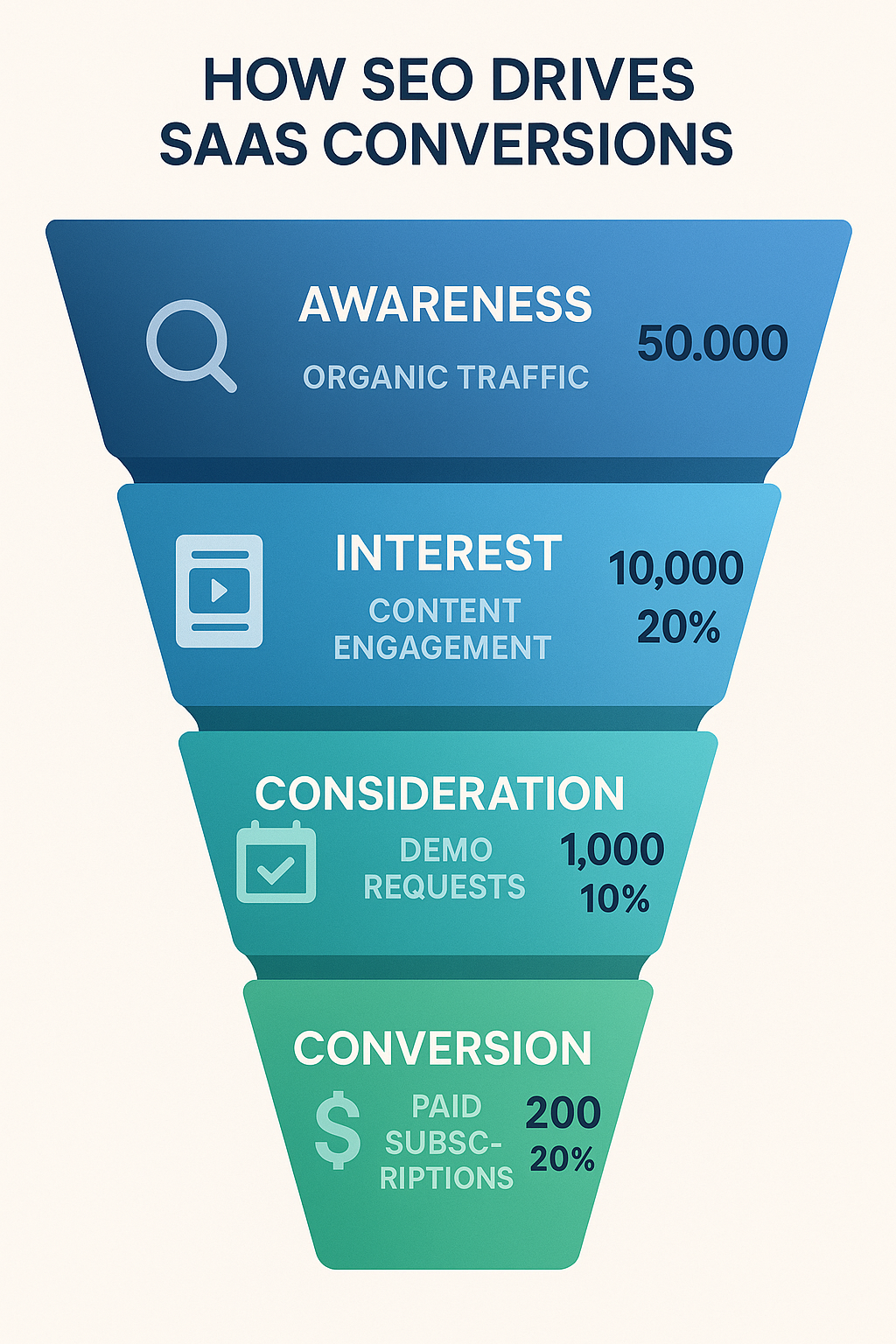
Understanding how organic traffic moves through your conversion funnel is essential for optimization:
Awareness Stage (Top of Funnel):
•Blog posts and educational content
•Problem-focused keywords
•Metrics: Traffic volume, time on page, bounce rate
Interest Stage (Middle of Funnel):
•Solution-focused content
•Product comparison pages
•Metrics: Page depth, email signups, content downloads
Consideration Stage (Bottom of Funnel):
•Product pages and demos
•Pricing and feature comparisons
•Metrics: Demo requests, trial signups, sales conversations
Conversion Stage:
•Free trial to paid conversion
•Upsell and expansion opportunities
•Metrics: Trial-to-paid rate, expansion revenue, customer lifetime value
Reporting and Dashboard Setup
Effective SEO reporting for SaaS companies should include:
Executive Dashboard:
•Revenue attribution from organic channels
•Customer acquisition cost trends
•ROI and growth projections
•Competitive position updates
Operational Dashboard:
•Traffic and ranking performance
•Content performance metrics
•Technical SEO health scores
•Link building progress
Strategic Dashboard:
•Market opportunity analysis
•Competitive gap identification
•Content strategy performance
•Long-term growth projections
Working with SEO Specialists: Investment vs In-House
The decision between hiring an SEO specialist, building an in-house team, or managing SEO internally significantly impacts both your investment requirements and revenue outcomes. Here's how to make the right choice for your SaaS company.
SEO Specialist vs In-House: Cost Analysis
Hiring an Experienced SEO Specialist:
Advantages:
•Immediate access to expertise and proven strategies
•Lower total cost than building internal team
•Faster implementation and results
•Access to premium tools and resources
•Objective, external perspective on your market
Investment Range:
•Freelance specialists: $75-$200/hour
•SEO agencies: $3,000-$15,000/month
•Dedicated consultants: $5,000-$20,000/month
Best for: Companies wanting fast results, lacking internal expertise, or needing specialized knowledge for competitive markets.
Building an In-House SEO Team:
Advantages:
•Deep product and market knowledge
•Long-term commitment and alignment
•Better integration with other marketing efforts
•Full control over strategy and execution
Investment Range:
•Junior SEO specialist: $50,000-$80,000/year
•Senior SEO manager: $80,000-$150,000/year
•SEO director: $120,000-$200,000/year
•Plus benefits, tools, and training costs
Best for: Large companies with substantial SEO budgets, complex technical requirements, or long-term strategic focus.
Hybrid Approach: The Best of Both Worlds
Many successful SaaS companies adopt a hybrid approach:
Phase 1 (Months 1-6): Work with an experienced SEO specialist to establish strategy, implement technical foundations, and train internal team.
Phase 2 (Months 7-12): Transition to hybrid model with specialist providing strategic oversight and internal team handling execution.
Phase 3 (Months 13+): Maintain specialist relationship for strategic guidance while internal team manages day-to-day operations.
Choosing the Right SEO Partner
When evaluating SEO specialists for your SaaS company, consider these factors:
SaaS-Specific Experience:
•Track record with B2B SaaS companies
•Understanding of complex sales cycles
•Experience with technical product marketing
•Knowledge of SaaS metrics and attribution
Geographic and Market Expertise:
•Experience in your target markets
•Understanding of local search behaviors
•Cultural and language considerations
•Regulatory and compliance knowledge
Technical Capabilities:
•Advanced technical SEO skills
•Experience with complex site architectures
•API and developer documentation optimization
•Integration with marketing automation systems
Strategic Thinking:
•Ability to align SEO with business objectives
•Understanding of competitive positioning
•Long-term growth planning capabilities
•Data-driven decision making approach
As an SEO specialist with extensive experience in SaaS companies across MENA, US, and Pakistani markets, I've seen how the right partnership can accelerate results by 6-12 months compared to going it alone. The key is finding someone who understands both the technical aspects of SEO and the unique challenges of SaaS business models.
Red Flags to Avoid
Unrealistic Promises:
•Guaranteed rankings or immediate results
•"Secret" techniques or algorithm insights
•Promises of specific traffic or revenue numbers
•Lack of transparency about methods
Poor Communication:
•Infrequent reporting or updates
•Technical jargon without business context
•Inability to explain strategy clearly
•Lack of responsiveness to questions
Outdated Approaches:
•Focus on keyword density over content quality
•Emphasis on quantity over quality in link building
•Neglect of technical SEO fundamentals
•Lack of mobile-first optimization
Conclusion: Making Your SEO Investment Decision
The data is clear: SaaS companies that invest strategically in SEO achieve remarkable returns, with average ROI reaching 702% over 24 months. However, success requires the right investment level, realistic timeline expectations, and strategic approach.
Key Takeaways for SaaS Executives
1.Investment Scaling: Start with foundation-level investment ($1,500-$4,500/month) and scale based on results and business growth.
2.Timeline Patience: Expect 7-9 months to breakeven, with peak ROI occurring in months 18-24.
3.Revenue Focus: Prioritize metrics that directly correlate with revenue: organic conversions, customer acquisition cost, and lifetime value.
4.Long-term Perspective: SEO becomes increasingly cost-effective over time, often becoming the primary acquisition channel for successful SaaS companies.
5.Strategic Partnership: Working with experienced SEO specialists accelerates results and reduces the risk of costly mistakes.
Your Next Steps
If you're ready to explore how SEO can drive revenue growth for your SaaS company:
1.Audit Your Current Position: Understand your baseline metrics and competitive landscape
2.Define Your Investment Level: Choose the tier that aligns with your growth goals and budget
3.Set Realistic Expectations: Plan for 6-12 month investment periods with long-term ROI focus
4.Choose Your Approach: Decide between specialist partnership, in-house development, or hybrid model
Ready to Accelerate Your SaaS Growth with Strategic SEO?
As an SEO specialist with proven experience helping SaaS companies achieve 300-700% ROI through strategic organic growth, I understand the unique challenges and opportunities in the SaaS market. Whether you're a startup looking to establish your organic presence or an enterprise company seeking to dominate your market, I can help you develop and execute an SEO strategy that drives measurable revenue growth.
My SaaS SEO services include:
•Comprehensive SEO audits and strategy development
•Technical SEO optimization for complex SaaS architectures
•Content strategies that convert prospects into customers
•Link building campaigns that establish market authority
•Advanced analytics and revenue attribution modeling
•Multi-market expansion strategies (MENA, US, Pakistan)
Ready to discuss your SEO investment strategy? Schedule a free consultation to explore how we can accelerate your organic growth and reduce your customer acquisition costs.
About the Author: Usman Tauqir is an SEO specialist with extensive experience helping SaaS companies achieve sustainable organic growth across global markets. With a focus on revenue-driven SEO strategies, Usman has helped companies reduce customer acquisition costs by 40-60% while building long-term competitive advantages through strategic search optimization.
Frequently Asked Questions
Q: How much should a SaaS startup invest in SEO?
A: SaaS startups should typically invest $1,500-$4,500/month in SEO, focusing on technical foundations and content creation. This investment level allows for meaningful progress while maintaining budget efficiency.
Q: When do SaaS companies typically see ROI from SEO?
A: Most SaaS companies reach SEO breakeven between months 7-9, with significant ROI (300-500%) typically achieved by month 12-18. Peak ROI often occurs in the second year of consistent investment.
Q: Is SEO more cost-effective than paid advertising for SaaS?
A: SEO becomes more cost-effective than paid advertising after 12-18 months of consistent investment. While PPC provides immediate results, SEO offers better long-term ROI and customer quality.
Q: What's the biggest mistake SaaS companies make with SEO?
A: The biggest mistake is expecting immediate results or inconsistent investment. SEO requires sustained commitment and realistic timeline expectations to achieve meaningful revenue impact.
Q: How do you measure SEO success for a SaaS company?
A: Focus on revenue-driven metrics: organic customer acquisition cost, conversion rates, customer lifetime value from organic channels, and overall revenue attribution. Traffic and rankings are important but secondary to business impact.

